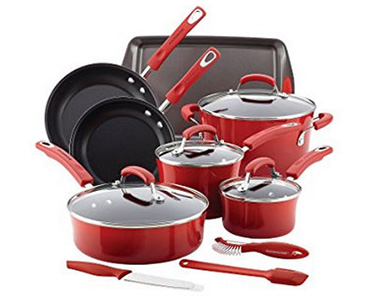 Kitchen Essentials: Cookware and Bakeware
Kitchen Essentials: Cookware and Bakeware
All pots and pans have common traits and basic functions. They may look different and tagged in a wide range of prices, but the good ones have something in common. Cookware and bakeware may look so basic but they are those whose characteristics are a little complicated and pricey. The materials used to make these vary, click here to learn more.
What to look for in a good pan?
Heavy-gauge materials are way better than the thin ones. The heavy-gauge materials spread heat evenly while the thin ones are hottest in the middle where the flame could be concentrated and not as much on the sides. Also, the bottoms of thin-gauge materials would dent out quickly.
The dent will cause food to concentrate in the middle, where there is high temperature, so this will result in burning at one part of the pan. When the bottom of your pans dent out, it becomes difficult for it to sit and balance on top of your electric stoves; so it can cause accidents and you can end up hurt. Heavy-gauge pans and pots deliver even heat inside, and this would mean evenly cooked food.
For you to know if the pan is heavy enough, you lift it up and look at the walls and base, rap the sides and base with your knuckles; listen carefully if you hear a light ping sound or a dull thud. It is the dull thud that you are looking for.
Good pans manage heat better, that is why they are worth the price. A heavy gauge and a good conductor are two features of good cookware.
Characteristics of a Good Cookware
They are made from metals that are good heat conductors. They are very responsive to high temperatures. They do what the heat source tells them to do, by the changes in temperature which they are sensitive to. You can warm them up or cool them down, almost instantly. Just like when you sauté garlic you would want your pan to be on the right heat when you drop the garlic. When the garlic is in the right spot, you would want to cool it down immediately to avoid burning it. Mere lifting the pan off the stove would immediately bring the temperature of the pan down; hence, avoiding burnt sautéed garlic.
They allow fast heat flow. This happens when you use a pan made of a good heat conductor material; this assures that temperature on the cooking surface will equalize quickly. Websites such as https://www.scienceofcooking.com/how-is-heat-transferred-in-cooking.html discuss the science of cooking which helps an individual decide which method to use in cooking.
A thicker pan allows for even heat diffusion. The distance between the source of heat and the cooking surface is more when you use a thick pan rather than when a thin one is used. This will lead to an even diffusion of heat on the cooking surface.
Higher temperature. Thick pans mean more mass, so it holds more heat. Higher temperatures would mean better browning, hotter frying, and faster reducing.
Strong handles, sturdy lid, heatproof and secure. Panhandles are either welded or screwed or riveted. Welded handles can easily break off if the welding is not of the quality or in the wrong spot. Some may advise not to buy welded handles because of the potential easy breakage, but some would also advise for welded ones compared to riveted handles. Riveted handles make it possible to collect residue around the rivet, this can be unsanitary.
 Different Materials Used to Make Pans and Pots
Different Materials Used to Make Pans and Pots
Stainless steel – this is a poor heat conductor if used by itself but a peerless surface that is easy to clean; it is durable, shiny, and is totally non-reactive.
Copper – is a superheat conductor and if kept polished, radiates visual warmth also. If used on its own, copper is very highly reactive to food, so if pans are made out of copper, it is the bottom layer that must be copper. Just for better conduction.
Aluminum – is a very good heat conductor, it is very much lighter than the other metals and easier to handle, but it is also highly reactive. Therefore, if used to create pots and pans, it is used in the core or bottom layer.
Cast iron – this is an excellent heat conductor and works great with high temperature, but the retainer of heat. Most heirloom cookware is made of cast iron. It just needs to be oiled regularly to avoid corrosion.
But enameled coating for cast iron pans solves the issue of maintenance. This coating does not affect the healing benefits, but it is also important to understand that the enamel coating can eventually chip off with wear and abrasion.
Choose the right cookware and bakeware to add to your kitchen outfit. While a lot of factors need to be considered, safety should always come first.
…
Home Series: How To Set Up Your Kitchen For Easy Cooking
Cooking Series: 6 Tips to Increase the Flavor of Your Dishes
4 All Natural Ingredients for Cleaning Your Wood Cutting Board
This post may contain automatically and manually added affiliate links,
which means I might receive a small commission if you make a purchase using a link at no extra cost to you.
